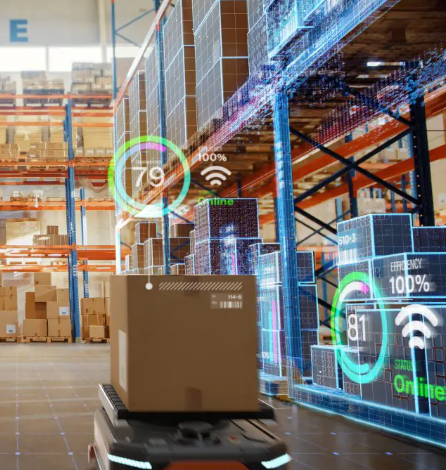Revolutionizing Logistics: How AI is Boosting Efficiency and Cutting Costs

The logistics industry is facing increasingly complex challenges in managing global supply chains, and businesses are under pressure to streamline operations while keeping costs under control. With AI’s ability to automate tasks, optimize processes, and enhance decision-making, logistics companies are finding innovative ways to reduce costs and improve efficiency. As we look ahead, AI is proving to be a game-changer in logistics management, offering solutions to the toughest operational hurdles.
In this article, we’ll explore the ways AI is transforming logistics, from demand forecasting and route optimization to predictive maintenance, and how it’s leading to significant cost savings and operational improvements.
The Role of AI in Logistics
Artificial intelligence (AI) has rapidly evolved in the logistics industry, driving major improvements in efficiency and cost management. Initially, AI was limited to automation tasks, but with advancements in machine learning and big data analytics, AI systems have become increasingly sophisticated. They now help logistics companies make data-driven decisions, forecast demand, optimize routes, and improve overall operational performance.
Machine learning allows AI systems to learn from large datasets, recognize trends, and make more informed decisions. This flexibility has made logistics operations more adaptable, enabling companies to better manage supply chain fluctuations, enhance customer service, and stay competitive in a rapidly evolving market.
Using AI to Reduce Logistics Costs
AI is playing a critical role in lowering logistics costs by optimizing key operational areas such as route planning, inventory management, and pricing strategies. Let’s take a closer look at how AI is reducing expenses and driving profitability.
- Predictive Analytics and Demand Forecasting
Accurate demand forecasting is vital for logistics efficiency. Traditional forecasting methods often fail to account for market fluctuations or unexpected disruptions. AI-driven predictive analytics, however, can analyze vast amounts of data from sales, market trends, and external factors, providing a much clearer picture of future demand. This enables businesses to adjust inventory levels, reduce overstocking, and minimize waste, which in turn saves costs and improves service reliability. - Route Optimization
AI’s impact on route planning has been profound, moving logistics beyond manual processes to sophisticated systems that dynamically adjust based on real-time data. AI-powered algorithms consider factors like delivery locations, traffic, road conditions, and fuel consumption, helping businesses plan the most efficient routes. The result is faster delivery times, reduced fuel costs, and lower carbon emissions. AI can also adapt routes on the fly to respond to traffic disruptions or weather changes, further optimizing delivery efficiency. - Dynamic Pricing
AI is reshaping how logistics companies set prices. Traditional pricing models often fail to account for the fast-changing nature of the market. AI, however, can adjust pricing dynamically based on real-time factors such as competitor pricing, market demand, and customer behavior. This allows logistics companies to optimize their pricing strategies, maximize profits, and improve customer satisfaction by offering competitive pricing that reflects current market conditions. - Supply Chain Management
AI simplifies supply chain management by offering better visibility into operations and providing real-time data. By analyzing sales trends, consumer behavior, and external influences such as weather patterns, AI helps businesses predict demand more accurately. This results in better stock management, lower carrying costs, and a reduced risk of stockouts or overstocking. - Improving Delivery Capacity
AI’s ability to optimize routes and vehicle utilization directly impacts delivery capacity. By identifying the most efficient delivery paths and reducing empty miles, AI enables logistics companies to make more deliveries with the same resources. This increased delivery capacity leads to higher revenue without the need for additional investment in trucks or staff. - Reducing Operational Costs
Effective route planning and resource optimization result in significant cost savings. By minimizing vehicle wear and tear, reducing fuel consumption, and avoiding delays, AI cuts operational expenses. Additionally, optimized logistics operations reduce the risk of penalties and fines due to late deliveries, improving overall cost efficiency.
How AI Enhances Operational Efficiency in Logistics
AI offers a variety of solutions that improve operational efficiency throughout the logistics process. By automating tasks and streamlining operations, AI ensures businesses operate smoothly, save time, and lower costs.
- Inventory Management
Managing inventory in the logistics industry can be challenging, especially with fluctuating demand. AI-enabled systems are transforming inventory management by analyzing real-time data and forecasting demand more accurately. This ensures businesses always have the right amount of stock, reducing excess inventory while avoiding stockouts. By improving inventory turnover, AI helps companies reduce carrying costs and optimize warehouse operations. - Warehouse Management
Warehouse operations are critical to logistics efficiency, and AI is helping streamline processes like inventory tracking, picking, and packing. Automated systems powered by AI reduce human errors and speed up operations, resulting in faster order fulfillment and reduced labor costs. AI also helps optimize warehouse layout by analyzing data to identify bottlenecks and improve the flow of goods within the facility. - Automated Vehicles
The rise of autonomous vehicles is revolutionizing logistics by improving delivery efficiency. AI allows self-driving trucks and drones to navigate traffic, optimize routes, and adapt to changing driving conditions. These vehicles can operate 24/7, which increases productivity and reduces labor costs. Furthermore, autonomous vehicles help lower fuel consumption and improve safety, driving down overall operational costs. - Predictive Maintenance
Traditional maintenance approaches in logistics tend to be reactive, which can lead to costly breakdowns and downtime. AI-powered predictive maintenance systems, however, can identify potential issues before they occur. By continuously monitoring vehicle and equipment performance, AI analyzes sensor data to predict failures and schedule maintenance before disruptions happen. This proactive approach minimizes downtime, reduces repair costs, and improves fleet reliability. - Automated Returns
Managing returns is a crucial aspect of logistics, and AI is streamlining this process. By automating the inspection and processing of returns, AI enables faster and more efficient return handling. This not only improves operational efficiency but also boosts customer satisfaction by ensuring quicker resolutions and better inventory management.
Case Study: AI Enhances Logistics for a Fortune 500 Company
One automotive retail and supply chain company leveraged AI to optimize its logistics operations, focusing on route planning, inventory management, and supply chain visibility. By implementing AI-powered route optimization, the company reduced delivery times by 25% and increased on-time deliveries by 20%. Advanced demand forecasting and automated inventory management helped lower transportation costs by 22% and reduced inventory holding costs by 30%. Overall, the company saw a 35% reduction in manual labor costs and a 12% increase in productivity, achieving full ROI within the first year.
Challenges of Implementing AI in Logistics
While the benefits of AI in logistics are clear, implementation comes with challenges. AI systems can be complex and costly to integrate, requiring significant investment in infrastructure, hardware, and training. Businesses must also ensure their AI solutions are scalable and compatible with existing systems. Additionally, there are operational hurdles, such as the need for continuous maintenance and upgrades of AI technology.
Conclusion
AI is transforming the logistics industry by offering solutions that streamline operations, reduce costs, and improve customer satisfaction. From predictive analytics to automated vehicles and intelligent supply chain management, AI is enhancing operational efficiency across the board. While there are challenges to overcome, businesses that embrace AI will gain a competitive edge and see significant returns in terms of cost savings and improved performance. The future of logistics is undeniably AI-driven, and companies that adopt these technologies will lead the way in the ever-evolving logistics landscape.




